German surrogate 13-15-mm anti-aircraft machine guns during the Second World War
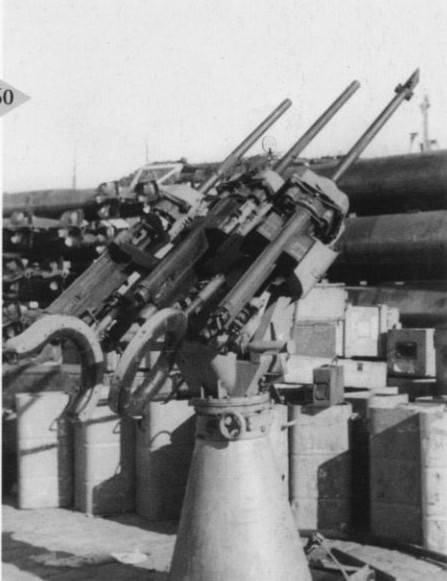
In the second half of the war, the Germans massively created anti-aircraft installations using aviation 13-15 mm machine guns. At first it was an initiative of ground airfield personnel, who, with the help of handicraft ZPUs, tried to protect themselves from enemy air raids, and then, due to an acute shortage of regular anti-aircraft installations, this began to happen centrally.
Although the surrogate large-caliber anti-aircraft machine gun mounts had a number of drawbacks, were sensitive to pollution and required more careful maintenance compared to land-based models, on the whole they turned out to be quite effective and justified themselves.
Large-caliber anti-aircraft machine guns in the German armed forces as of June 22, 1941
Before starting a story about anti-aircraft machine guns created on the basis of German 13-15 mm aircraft machine guns, let's consider the most common captured heavy machine guns that were in the German army as of June 22, 1941.
Formally, in the armed forces of Nazi Germany there were no specially designed German-made heavy machine guns intended for use by ground units, and the niche of these machine guns was occupied by very successful 20-mm artillery machines. However, this weapon by the time of the attack on the USSR, the troops still had it, and it was actively used for firing at both ground and air targets.
In France, the trophies of the Wehrmacht were several hundred single-barreled, twin and quadruple anti-aircraft machine gun mounts, built on the basis of the 13,2 mm Hotchkiss Мle 1930 machine gun.
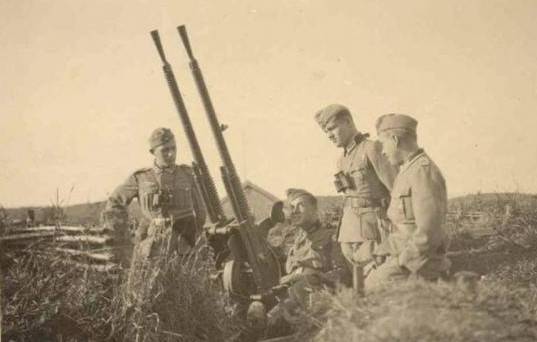
Twin 13,2 mm French-made anti-aircraft gun, captured by the Germans
The Hotchkiss Мle 1930 machine gun was designed for the 13,2 × 99 mm cartridge. Machine gun automation worked on the principle of a gas outlet with a long stroke, located under the gas piston barrel. The machine gun had a replaceable air-cooled barrel with characteristic fins. The body of the machine gun weighed about 40 kg, the weight of the weapon on a universal tripod machine without cartridges was 98 kg. Rate of fire - 450 rds / min.
A bullet weighing 52 g left the barrel with an initial velocity of 790 m/s. The range of ammunition included cartridges with conventional, incendiary, tracer, armor-piercing incendiary and armor-piercing tracer bullets, which made it possible to successfully deal with low-flying aircraft and light armored vehicles.
The Hotchkiss Mle 1930 machine guns used by Wehrmacht units were designated MG 271(f). In the anti-aircraft units of the Luftwaffe, they were referred to as 1,32 cm Flak 271 (f).
In the Czech Republic, Yugoslavia, Greece and near Dunkirk, German troops captured approximately two hundred 15-mm heavy machine guns ZB-60 and Besa Mk.1 (British licensed version of the ZB-60). The automation of a heavy machine gun worked on the principle of removing part of the powder gases. The device and scheme of work were largely identical to the easel 7,92-mm machine gun ZB-53. After being installed on a universal wheel-tripod machine, the ZB-60 was able to fire at air targets. The body weight of the machine gun without the machine was 59 kg. The machine gun was powered from a box with a tape for 40 rounds. Rate of fire - 410-430 rds / min.
The ammunition included cartridges with armor-piercing and tracer bullets. The pyrotechnic composition of the tracer bullet burned at a distance of up to 2000 m. Due to the strong recoil, firing bursts of more than 2-3 shots at an air target was ineffective, which was largely determined by the unsuccessful design of the machine with too high an anti-aircraft rack. If a 15 mm Czech machine gun was rigidly attached to a pedestal mounted on a solid base, the accuracy of shooting became acceptable.
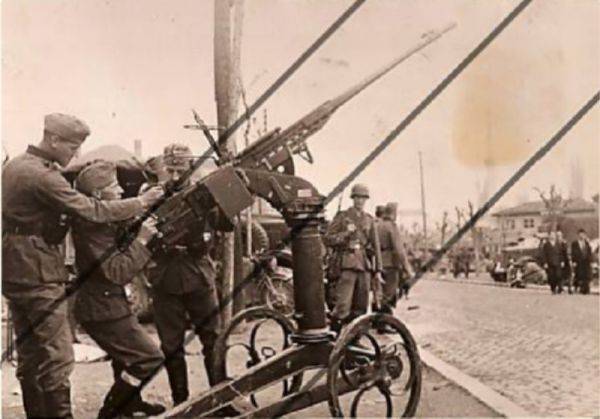
German soldiers with a 15 mm ZB-60 machine gun in anti-aircraft firing position
After the Czech Republic became the protectorate of Bohemia and Moravia, about a hundred 15-mm machine guns were produced at the Hermann-Göring-Werke enterprise (as the Škoda factories began to be called under the Germans). They were used by SS units, Luftwaffe and Kriegsmarine anti-aircraft gunners. In German documents, this weapon was designated as MG.38 (t). Despite the fact that there were relatively few such machine guns, they remained in service until the end of hostilities.
Due to the modest range of available Czech ammunition and their relatively low armor penetration, the Germans used the same bullets to equip 15-mm cartridges as for MG.151 / 15 aircraft machine guns. This approach also made it possible, thanks to partial unification, to reduce costs in the production of cartridges. A powerful 15 × 104 mm cartridge had a muzzle energy of more than 30 J. A 000 g bullet in a 75 mm barrel accelerated to a speed of 1400 m / s and pierced 880 mm armor at a distance of 500 m along the normal.
Anti-aircraft installations created on the basis of 13-15-mm German aircraft machine guns
In the mid-1930s, it became clear that rifle-caliber aircraft machine guns were not as effective against aircraft made using light alloys as they were against airplanes built from wood and percale. In connection with the active design of all-metal fighters and bombers in other countries, the Luftwaffe command ordered Rheinmetall AG to create a 13-mm machine gun.
Tests of the MG.131 aviation machine gun chambered for 13x64 mm began in the first half of 1938. Since this cartridge was the weakest in its class, it was possible to create a very light and compact heavy machine gun for it. German designers designed and embodied in metal a very compact and light weapon, in terms of weight and size characteristics comparable to rifle-caliber aircraft machine guns.
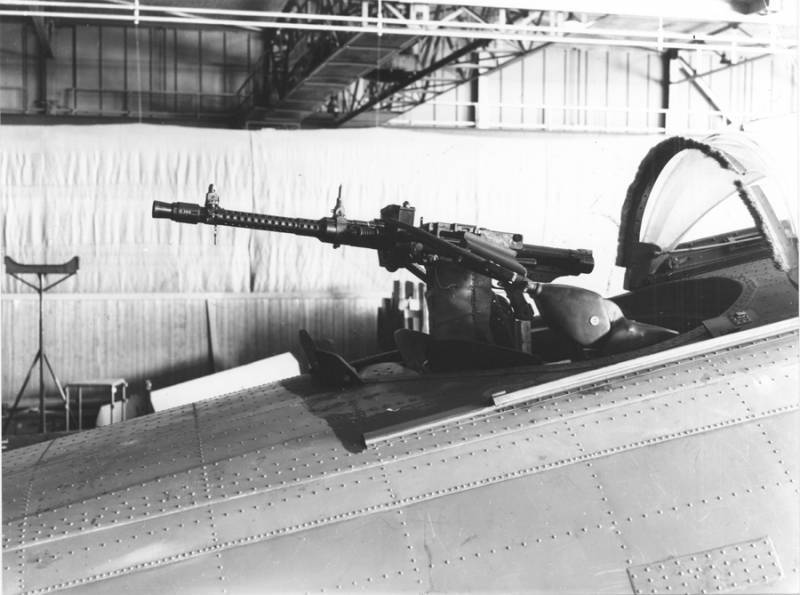
13 mm turret machine gun MG.131
The weight of the turret machine gun without cartridges was 16,6 kg, and the length was 1168 mm. For comparison: the mass of the Soviet 12,7 mm UBT aviation machine gun exceeded 21 kg with a length of 1400 mm.
Structurally and according to the principle of operation, the MG.131 largely repeated the MG.15 and MG.17 machine guns. The automation of the 13-mm aircraft machine gun worked on the principle of short-stroke recoil. Locking was carried out by turning the clutch. The barrel was cooled by air flow.
The MG.131 machine gun had a good rate of fire for its caliber - up to 950 rds / min, but the relative low power of the cartridge, combined with the low mass of the projectile and low initial speed, limited the range of effective fire. In addition, the not very successful shape of the bullet reduced the ballistic characteristics. Nevertheless, due to its good reliability and low weight, the MG.131 was popular with German aircrew and gunsmiths.
To some extent, the relatively low muzzle energy was compensated by the available ammunition. The ammunition load of the MG.131 aviation machine guns included 13-mm machine-gun cartridges with various types of bullets with an initial speed of 710-750 m/s.
A fragmentation-incendiary-tracer bullet weighing 34 g contained 1 g of phlegmatized heating element and a thermite incendiary composition. In the bottom part of the armor-piercing tracer bullet weighing 38,5 g, there was a tracer pyrotechnic composition. An armor-piercing incendiary bullet weighing 38,5 g was equipped with white phosphorus, which ignited combustible materials after breaking through the barrier. In the body of the incendiary tracer bullet, which weighed 36 g, there was a thermite composition, and in the bottom part there was a tracer.
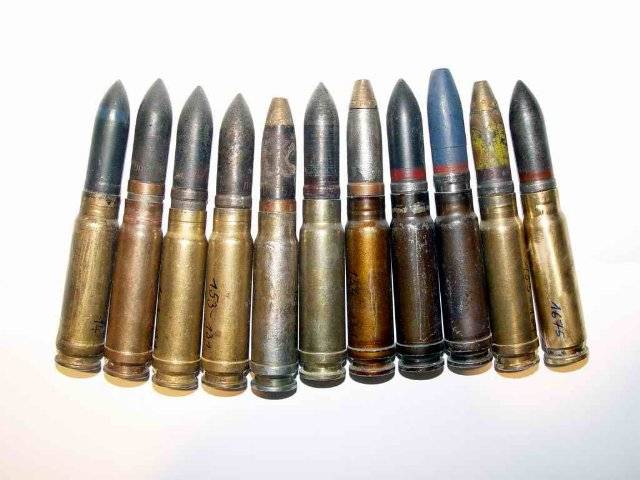
13 mm cartridges of various types for the MG.131 machine gun
A characteristic feature of the machine gun ammunition was the presence of a leading copper belt on the bullets, which in the modern classification would classify these weapons not as machine guns, but as small-caliber artillery systems.
The production of 13 mm aircraft machine guns continued until the second half of 1944, with a total of more than 60 units produced. At the end of 000, more than 1944 machine guns and 8 million cartridges for them remained in the warehouses.
From the middle of 1944, the MG.131s in storage were converted for the needs of the Wehrmacht. In total, 8132 machine guns were transferred to the disposal of the ground forces, and they were installed on light machine tools and even bipods. This was possible due to the relatively small mass of weapons for this caliber and acceptable recoil. However, aimed shooting from bipods was possible only with a burst length of no more than 3 shots.
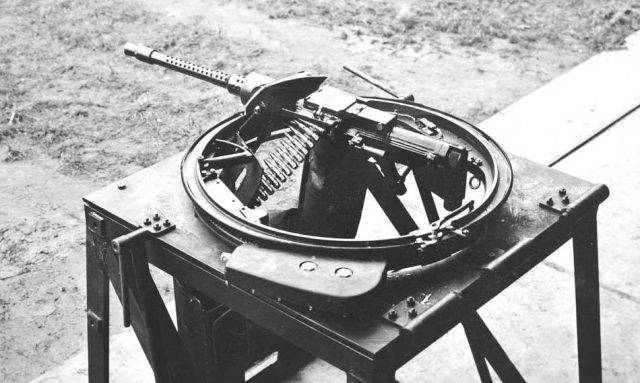
13 mm MG.131 machine gun on a ground mount
In order to ensure air defense of field airfields, MG.131 machine guns began to be actively used in 1943. To do this, they used machine gun turrets taken from decommissioned bombers and mounted them on simple swivels.
Sometimes aircraft turrets designed for bombers were installed on ground positions in the vicinity of airfields.
Even taking into account the fact that the MG.131 was often criticized for its insufficient power for such a caliber, 13 mm armor-piercing tracer and armor-piercing incendiary bullets at a distance of 300 m confidently pierced the 6 mm side armor of the Il-2 attack aircraft, and in terms of the effectiveness of firing at for air targets, the ZPU based on the 13-mm machine gun MG.131 was superior to rifle-caliber anti-aircraft guns.
In 1940, Mauser-Werke AG began production of the 15 mm MG.151/15 machine gun. Thanks to the use of a number of successful design solutions, it had characteristics unique for its time, which, along with well-developed ammunition, ensured its superiority over other aircraft systems of 12,7 - 20 mm calibers in terms of muzzle energy of the projectile and armor-piercing action. Due to the high muzzle velocity, the MG.151/15 had very good shooting accuracy.
The action of the automation of the 15-mm aircraft machine gun was based on the use of the recoil of a moving barrel, with which the bolt was firmly engaged during the shot. In this case, when fired, the barrel rolls back along with the bolt. Such a scheme provides a snug fit of the sleeve to the walls of the chamber before the projectile leaves the barrel, which in turn makes it possible to increase the pressure in the barrel and provides a higher initial speed compared to weapons with a blowback. The MG.151/15 uses short-travel recoil, which is less than the bolt stroke. The barrel bore is locked by turning the combat larva. Slider type feeder. With a machine gun body weight of about 43 kg, the total length was 1766 mm. Barrel length - 1104 mm. Rate of fire - 600-750 rds / min.
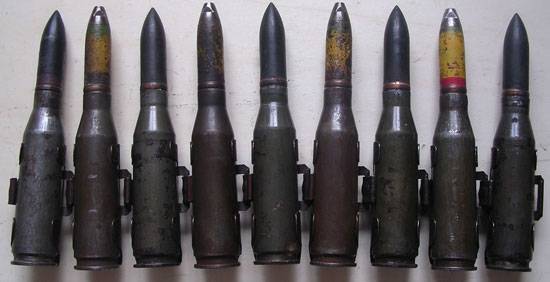
Ribbon link with 15 mm cartridges
An armor-piercing tracer 15-mm bullet weighing 72 g was accelerated in the barrel to 850 m / s. At a range of 300 m, it normally confidently pierced 20 mm armor of medium hardness. In the course of special tests of armored hulls of single-seat Il-2, carried out at factory No. 125 in the summer of 1942, when fired from a German heavy machine gun MG.151 / 15, it was found that 6 mm thick side armor plates do not provide protection against armor-piercing 15-mm bullets from a distance less than 400 m at an angle to the longitudinal axis of the aircraft over 20°. The sub-caliber 52 g bullet with a carbide core had even greater armor penetration. After leaving the barrel, she had an initial speed of 1030 m / s and under the same conditions could penetrate 40-mm armor. However, due to the acute shortage of tungsten, cartridges with sub-caliber bullets for firing at air targets were purposefully not used.
For firing at air targets, cartridges were also used with a fragmentation-incendiary bullet (instant action), containing 4,5 g of an explosive charge, and fragmentation-incendiary-tracer, equipped with 1,95 g of explosives and 1,4 g of tracer composition.
Despite good accuracy and high armor penetration, the MG.151/15 machine gun proved to be insufficiently effective against heavy bombers. 15-mm fragmentation-incendiary-tracer and fragmentation-incendiary bullets had insufficient destructive power when exposed to structural elements of heavy aircraft.
Fighters BF-109F-2, armed with MG.151/15, successfully hit all types of single-engine combat aircraft, including armored Il-2, as well as twin-engine domestic, American and British front-line bombers at real air combat distances. However, attempts to intercept four-engine British heavy bombers demonstrated the insufficient effectiveness of the 15-mm aircraft machine gun. In this regard, in 1941, Mauser-Werke AG, based on the MG.151 / 15 machine gun, created the 20-mm MG.151 / 20 cannon, which was widely used as the main armament of fighters of various modifications, and the released 15-mm aircraft machine guns used to create anti-aircraft installations. At the same time, the weapon was subjected to alteration regarding the trigger mechanism and reloading device. The electric trigger and pneumatic reloading were replaced by mechanical units.
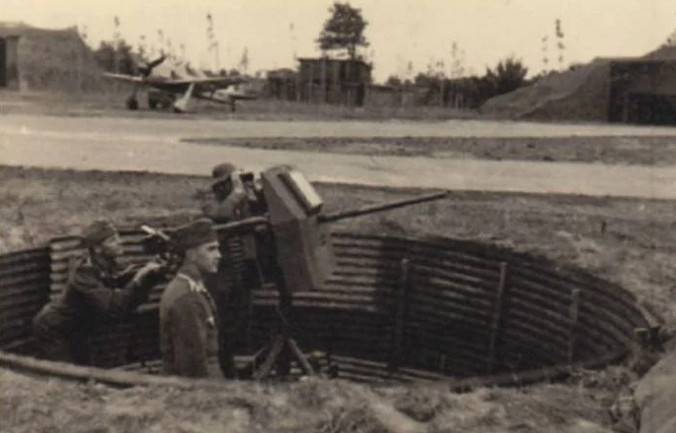
Anti-aircraft installation using a 15-mm machine gun MG.151/15
The first anti-aircraft installations, created by aviation gunsmiths using MG.151 / 15 machine guns, were installed on the simplest bases and, as a rule, were placed on stationary firing positions that covered airfields. Sometimes single-barrel ZPUs were equipped with armored shields. However, this variant has not received wide distribution.
Much more often, single MG.151/15 heavy machine guns were mounted on pedestals, which were fixed on a rigid base. Anti-aircraft mounts were placed on stationary positions, towed trailers, vehicles and railway platforms.
For the Kriegsmarine, using MG.151 / 15, twin anti-aircraft installations were created, which were installed on some Type IX submarines and Schnellboot 26 torpedo boats.
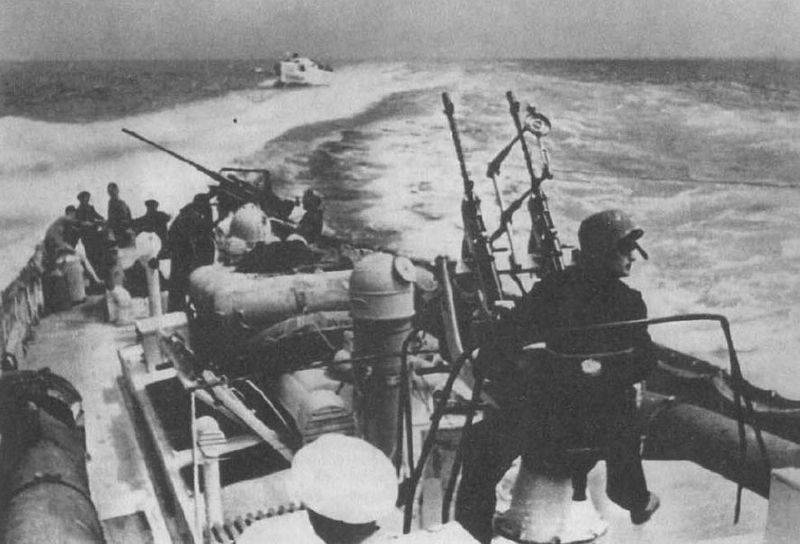
Twin ZPU using 15 mm machine guns on a Schnellboot 26 torpedo boat
If the 15-mm ZPU took root on the boats, then the submariners soon abandoned them. During an urgent dive, there was no time to remove the bulky installation and lower it inside the boat, and swimming in sea water had an extremely negative effect on delicate aircraft machine guns.
The most massive was the built-in installation on the Flalaf.SL151.D machine, in which the machine guns were located horizontally. All three trunks had a common descent. The built installation had a solid ammunition. At least 300 rounds of ammunition were placed in boxes fixed parallel to the pedestal. The total rate of fire of the three-barreled installation reached 2250 rds / min, and a second salvo was 0,65 kg.
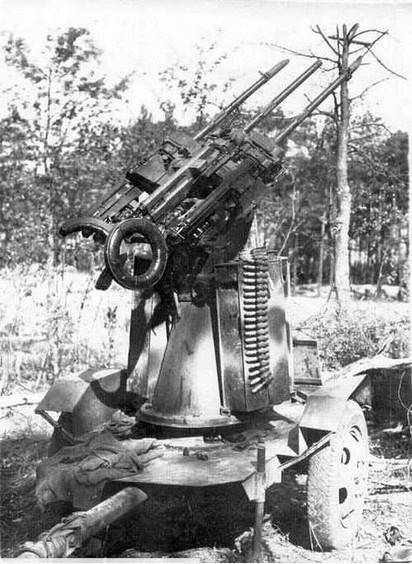
At the same time, the built-in installation had a number of disadvantages. To quickly aim it at the target, the shooter had to make great efforts, which adversely affected accuracy. The weapon, designed to aviation standards, was very sensitive to dust, carbon contamination and grease. But with proper care, 15-mm anti-aircraft machine guns turned out to be quite a formidable weapon. Due to the high initial velocity of the bullet, the range of aimed fire was 2000 m, and the armor penetration made it possible to overcome any aviation armor that existed at that time.
To be continued ...
- Linnik Sergey
- Soviet aircraft machine guns and cannons used in air defense in the initial period of the Great Patriotic War
Surrogate 7,92-mm anti-aircraft machine gun mounts of the German armed forces during the Second World War
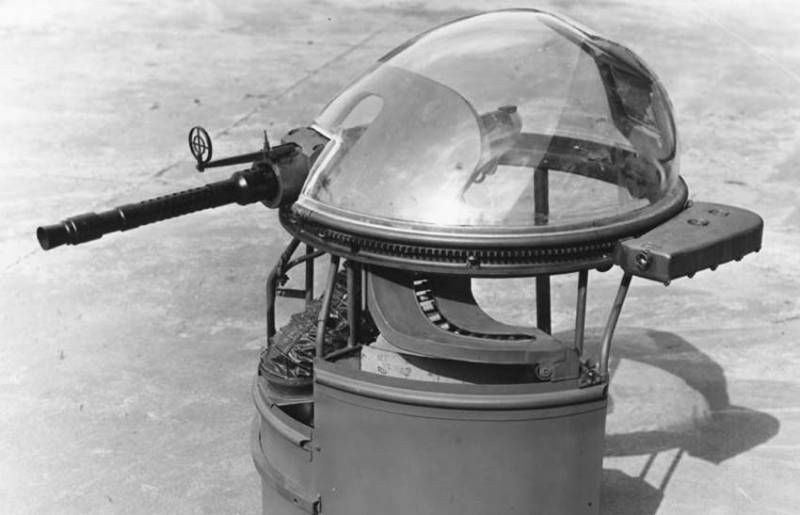
Information